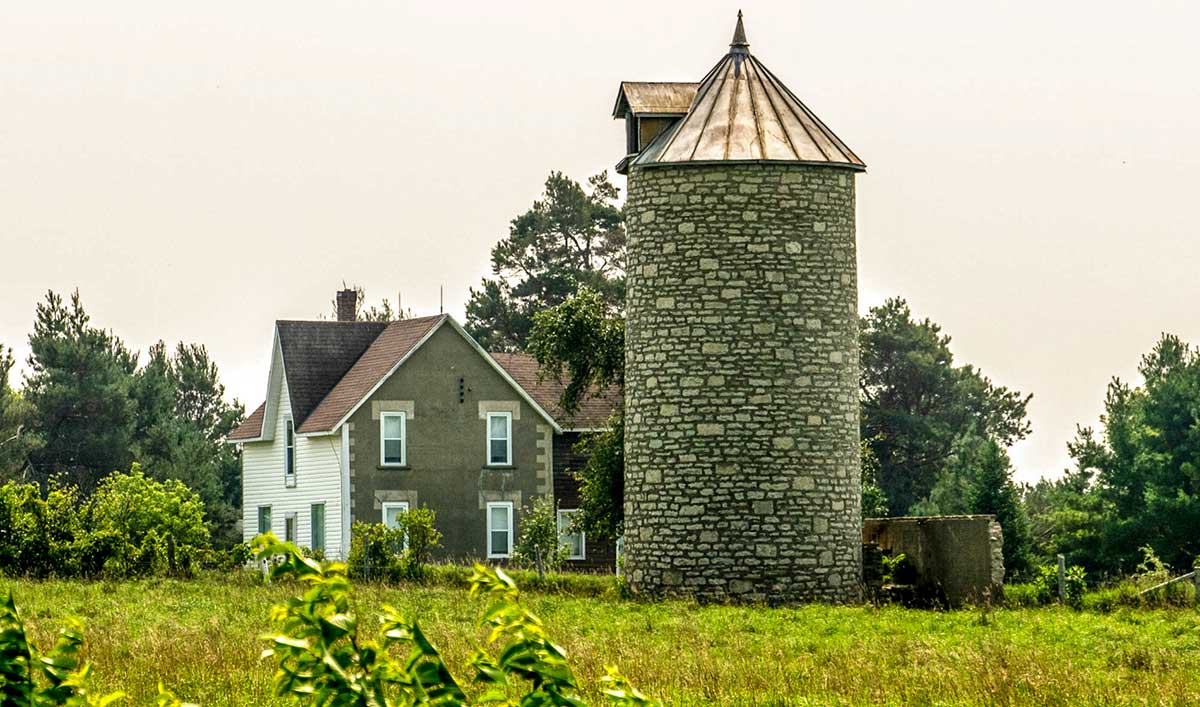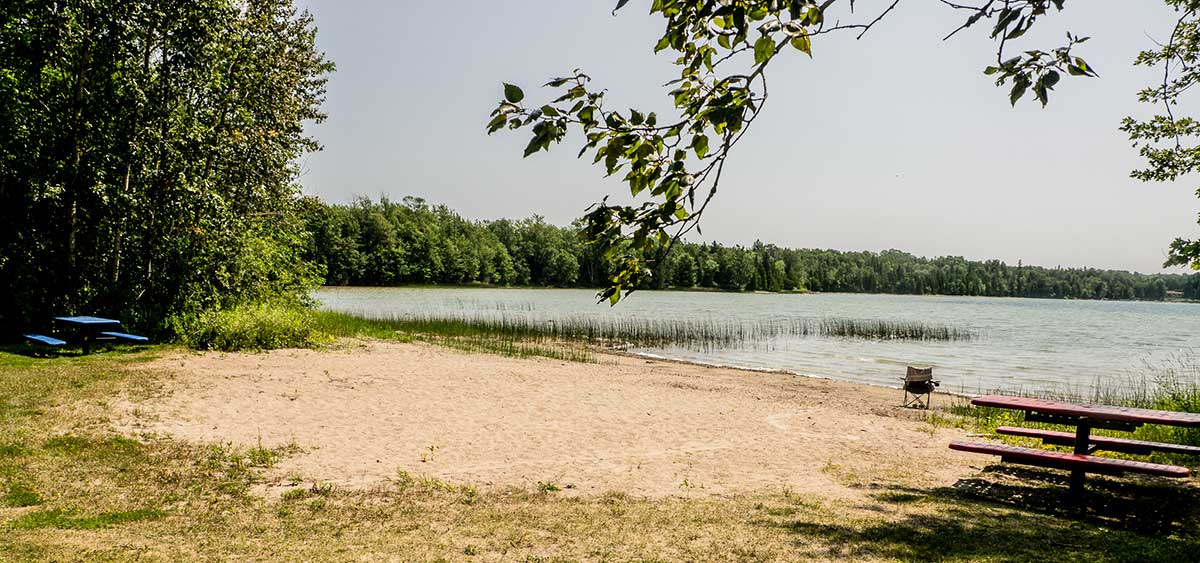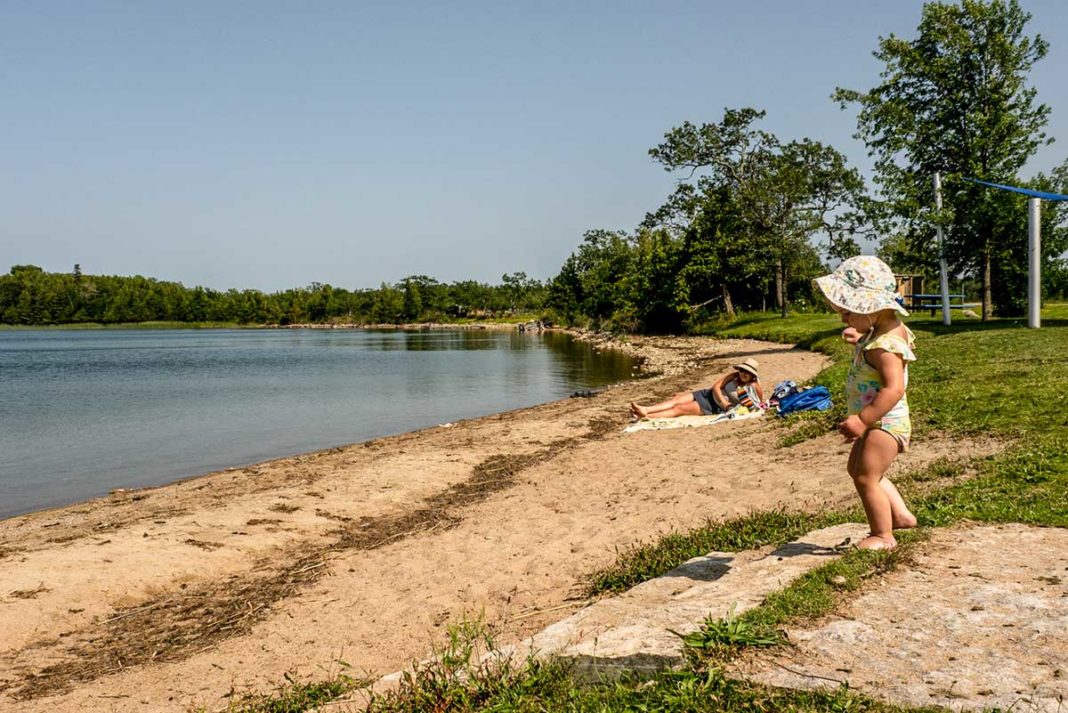By Isobel Harry
GORDON/BARRIE ISLAND – Not far from Gore Bay yet worlds away are two very different sandy beaches nestled within the pastoral, agricultural landscape of nearby Gordon/Barrie Island. Often a little quieter, these beaches are a bit off the beaten path, just enough to feel like maybe you’ve stumbled upon a secret spot known only to a select few.
The township of Gordon was surveyed in 1871-72 and amalgamated with Barrie Island (settled in 1878) in 2009; together they stretch along both sides of Gore Bay’s v-shaped bay, into the surrounding large farmlands to the south, east and west onto Barrie Island over a causeway. The Town of Gore Bay is a separate entity, incorporated in 1890.
According to historian Pat Best in her excellent ‘History of Gordon Township’ (at the Gore Bay Library), settlers first arrived in Gore Bay in 1869, landing on a “low and completely swampy” shore that was “wet and covered with undergrowth.” Up the hill above the bay they climbed “to dry, fertile land,” slowly establishing themselves south of the growing town, in Gordon Township, as homesteaders on large, forested tracts of land granted by the Crown.
Along the way to the beach may be seen many of these agricultural lands, big farms, barns and pastures laid out in grids, cleared and settled long ago.
From Hwy 540 at Gore Bay, turn south onto Poplar Road; the farms start here, many still owned and operated by descendants of the original settler families. A unique stone silo at “the old Willett place,” now unused, stands like a monument to perseverance, crafted by local stonemasons Stewart Clarke and his son, Stewart Clarke Jr., in the 1920s.
Just past here is an intersection with the 7th Line on the right (we’ll come back here to get to the second beach); take the promisingly-named Golf Course Road on the left. About halfway down this leafy, gently hilly road, go straight ahead when it turns sharply left, down a little lane called Ida’s Road. You can see the water from here: Tobacco Lake Beach.
This small park and beach established by the municipality for public use is a tranquil spot at the northern end of Tobacco Lake, long a summer outpost for camps and cottages since the earliest days. You might find yourself quite alone here, or in the company of a canoeist going out for a paddle or of a family overseeing the kids in the water; on a hot summer’s day, this is an ideal spot to refresh the spirits with a swim in the lake and a reviving snack at a picnic table. A gazebo for shade, a bench or two, washroom (when permitted by pandemic regulations), a lawn and that sand beach make for some pretty pleasant surroundings down here away from everything.
Golf Course Road carries on past here a short way, reaching Hwy 542 at the end. At this corner are the lush, undulating greens of Manitoulin Golf, a popular public 9-hole course with rental clubs and carts; the licenced Clubhouse restaurant’s covered patio overlooks the course and there are take-out options galore. A wonderful few hours can be spent in this undisturbed corner of the Island: a round of golf, a bite to go from the restaurant, a refreshing swim just up the road, picnic at the beach and Bob’s your uncle, all on this cool little rural route.
Backtrack on Golf Course Road, across the Poplar Road intersection, west onto the 7th Line. The large farms on both sides of the road were registered in the late 1870s and many are still being worked today by succeeding generations of the first owners. There are homes and barns and outbuildings that have stood the test of time here; the old stone schoolhouse, SS No. 4, was constructed by the Clarkes in 1926 on a farmer’s donated acre at the corner of Noble Sideroad (now private). This area was known as Foxey (no reason has ever been disinterred), with the Foxey post office, the last rural post office built on the Island, standing near here from 1911 until 1937.

The 7th Line meets Hwy 540 as it curves westward; turn right (east) here to find the second beach on the day’s itinerary; a couple of kilometres up the road is the turnoff (left) onto Barrie Island.
If you haven’t been to Barrie Island, you probably think of Manitoulin as a pretty peaceful place; well, of course it is, but to step onto this particular land mass is to experience peace of another order.
Known today primarily for its stellar bird watching opportunities (eagles, Sandhill cranes, grouse-mating rituals), the vast island’s two commercial enterprises are comprised of the Northland Agromart outlet for agricultural equipment, supplies and animal feed, and the Gore-Bay Manitoulin Airport, built in 1947, with lighted runway and many aviation services including a Canada Customs office, refueling, hangars and a lounge. gorebayairport.com
Bring nutrition and hydration–no-one is going to hear your stomach rumblings out here as you glide along the low limestone plateau to the beach on the North Channel. Then, you can spend several hours exploring the large farms on concession roads and the far reaches of this vast, out of the way place; Barrie Island has only ever counted about 20 farms, making for a very bucolic setting for a bicycle or car tour.
But it’s not far to the beach–just past the airport, down a hill, around a curve lies Julia Bay and its alluring arc of sand. Julia Bay Beach offers a sandy, gradually sloping lake bottom and floating dock for sunning and jumping from. The view over the bay is grand; there’s a small gazebo at water’s edge, benches, a picnic table with sail awning, a big Manitoulin Cycling Routes map marked with the Barrie Island route and room to stretch out on the sand or the lawn.
It is generally quiet here but can fill up on those hot afternoons; out on the dock a young lad dives over and over into the cool, calm water then comes in to hop on his bike to head home, On the sand, Jessica Clements and daughter Charlotte have come from Gore Bay to relax and have fun in this play-perfect place. Having moved with her family from west of Thunder Bay last May, Ms. Clements is rhapsodic about Manitoulin in summer, although, she says, “I love winter! I can’t wait for Manitoulin winter!” To which we say, ‘all in good time, Ms. Clements, all in good time.’

In ‘One Tree on an Island: The Roots of Barrie Island’ by Joe Ann Baker Lane Lewis, a fascinating 395-page hardcover tome (at the Gore Bay Library), the author notes the presence of the first summer home in about 1878, “a trend that continues today, as individuals have always loved to spend the summer months amidst the natural, rugged beauty of the land.” Indeed, there are many homes and summer residences here now that have no farming ties except to their neighbours in the community.
Ms. Baker Lane Lewis offers a peek into daily life back then, the hard work and harsh conditions of settlement, the school, post office, annual Christmas concert, barn dances and the famous “oyster suppers” of the Barrie Island Women’s Institute in the early 1900s; the oysters “were purchased at the store in Gore Bay,” she writes, thoughtfully including the recipe for oysters dredged in cracker crumbs and deep fried.
Gordon/Barrie Island beaches sandily invite a lie-down, there perhaps to entertain visions of barn dances and oyster suppers, or of nothing much at all.





